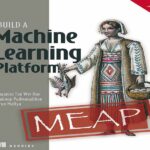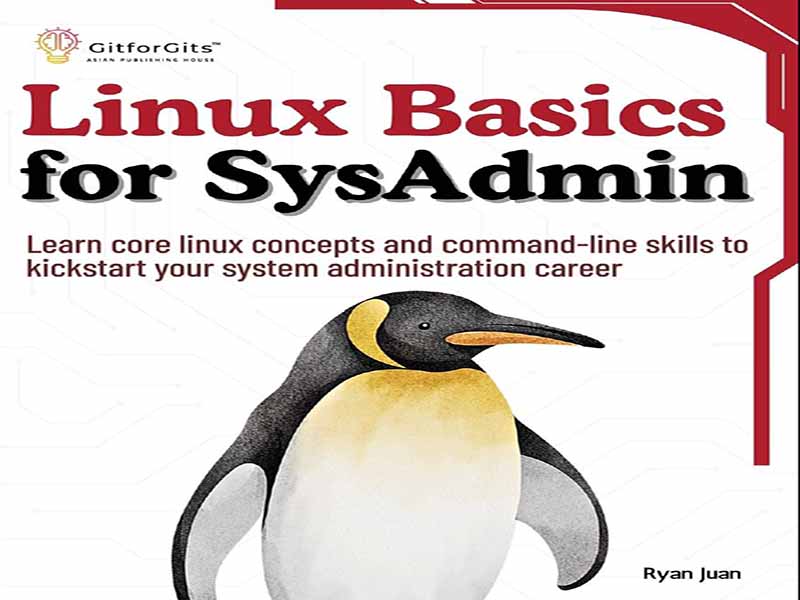- عنوان کتاب: Linux Basics for SysAdmin
- نویسنده: Ryan Juan
- حوزه: مدیریت لینوکس
- سال انتشار: 2024
- تعداد صفحه: 456
- زبان اصلی: انگلیسی
- نوع فایل: pdf
- حجم فایل: 1.03 مگابایت
شما به «مبانی لینوکس برای SysAdmin» رسیدهاید، کتابی که اصول لینوکس را به شما آموزش میدهد تا بتوانید با اطمینان سیستمهای لینوکس را مدیریت کنید. چه یک متخصص فناوری اطلاعات باتجربه باشید که به دنبال تقویت مهارتهای خود، چه یک دانشآموز مشتاق یادگیری لینوکس، و چه فردی بین این دو باشید، این کتاب تمام چیزهایی را که برای تبدیل شدن به یک مدیر سیستم شایسته نیاز دارید، پوشش میدهد. تعداد زیادی از رایانهها، کامپیوترهای رومیزی و دستگاههای تلفن همراه در سراسر جهان به دلیل انعطافپذیری و قدرت لینوکس، از آن استفاده میکنند. لینوکس به دلیل ماهیت متنباز، استحکام و سازگاریاش، یک دارایی ارزشمند برای بخش فناوری اطلاعات است. اگر میخواهید به یک کاربر متخصص لینوکس تبدیل شوید، درک مفاهیم اساسی که سیستمهای لینوکس را ایمن، کارآمد و قابل اعتماد میکنند، مهمتر از دانستن صرف دستورات و پیکربندیها است. این کتاب با شروع از اصول اولیه، زمینهای را که برای مهارت یافتن در لینوکس نیاز دارید، در اختیار شما قرار میدهد. فصل اول «راهاندازی و اجرای سیستمهای لینوکس»، مروری بر محیط لینوکس ارائه میدهد. درک اساسی از پوسته، مدیریت فایل و دایرکتوری و نحو دستورات پوشش داده خواهد شد. همچنین اصول اولیه شروع و خاموش کردن سیستم، مدیریت بستهها و ابزارهای مورد نیاز برای مدیریت لینوکس را بررسی خواهیم کرد. در ادامه، در فصل 2، “مدیریت سیستمهای لینوکس”، مدیریت سیستم را با جزئیات بیشتری بررسی خواهیم کرد. جزئیات فایلهای پیکربندی را کشف کنید، نحوه استفاده از systemd برای کنترل سرویسها، crontab برای برنامهریزی فعالیتها و نظارت بر عملکرد سیستم را بیاموزید. پارتیشنبندی دیسکها، مدیریت فایلهای لاگ و مدیریت از راه دور مبتنی بر SSH، همگی در این فصل پوشش داده شدهاند. وقتی صحبت از مدیریت نرمافزار و سختافزار میشود، فصل 3 جایی است که در آن قرار دارد. این فصل جزئیات استفاده از apt و yum برای مدیریت بسته، مدیریت وابستگیها، پیکربندی سختافزار سیستم و ارتقاء هسته را به شما آموزش میدهد. Docker و VirtualBox، دو ابزار محبوب برای ایجاد و مدیریت ماشینهای مجازی، نیز در این فصل پوشش داده شدهاند. فصل 4، “مدیریت کاربر و مجوزها”، نحوه مدیریت کاربران و مجوزها را مورد بحث قرار میدهد. لیستهای کنترل دسترسی (ACL)، تنظیمات مالکیت و مجوز فایل، ویرایش پروفایل کاربر و ایجاد و مدیریت حساب، همگی بخشی از چیزی هستند که میتوانید انتظار داشته باشید. شما همچنین مسئول مدیریت عضویت در گروهها، کار با ماژولهای احراز هویت قابل اتصال (PAM)، پیادهسازی محدودیتهای رمز عبور، پیکربندی sudo و جلسات کاربر خواهید بود. این کتاب مفاهیم اصلی مدیریت سیستم لینوکس را به صورت عملی در اختیار شما قرار میدهد، بنابراین میتوانید با اطمینان خاطر مدیریت سیستمهای خود را شروع کنید. شروع از اینجا شما را در مسیر شغلی IT که میخواهید، بسیار پیش خواهد برد و شما را به یک مدیر سیستم لینوکس متخصص تبدیل میکند.
You have arrived at “Linux Basics for SysAdmin,” a book that will teach you the ropes of Linux so that you may confidently administer Linux systems. Whether you’re an experienced IT professional looking to hone your skills, a student eager to learn Linux, or someone in between, this book will cover all you need to know to become a competent system administrator. A large number of computers, desktops, and mobile devices throughout the globe run Linux because of its flexibility and power. It is a priceless asset to the IT sector due to its open-source nature, robustness, and adaptability. Understanding the fundamental concepts that make Linux systems secure, efficient, and dependable is more important than simply knowing commands and configurations if you want to become an expert Linux user. Beginning with the fundamentals, this book will provide you with the groundwork you need to become proficient with Linux. “Up and Running with Linux Systems,” the first chapter, provides an overview of the Linux environment. A fundamental understanding of the shell, file and directory management, and command syntax will be covered. We also go over the basics of system starting and shutdown, managing packages, and the utilities that are needed for Linux administration. Next, in Chapter 2, “Managing Linux Systems,” we will explore system management in more detail. Discover the ins and outs of configuration files, learn how to use systemd to control services, crontab to schedule activities, and monitor system performance. Partitioning disks, managing log files, and SSH-based remote administration are all covered in this chapter. When it comes to managing software and hardware, Chapter 3 is where it’s at. This chapter will teach you the ins and outs of using apt and yum for package management, dealing with dependencies, configuring your system’s hardware, and upgrading the kernel. Docker and VirtualBox, two popular tools for creating and managing virtual machines, are also covered in this chapter. Chapter 4, “User and Permission Management,” discusses how to manage users and permissions. Access Control Lists (ACLs), file ownership and permission settings, user profile editing, and account creation and management are all part of what you can expect. You will also be responsible for managing group memberships, working with Pluggable Authentication Modules (PAM), implementing password restrictions, configuring sudo, and user sessions. This book will provide you the core concepts of Linux system administration practically, so you can start managing your systems with confidence. Starting here will go you far in the IT career path you desire by making you an expert Linux system administrator.
این کتاب را میتوانید از لینک زیر بصورت رایگان دانلود کنید:
Download: Linux Basics for SysAdmin



































نظرات کاربران